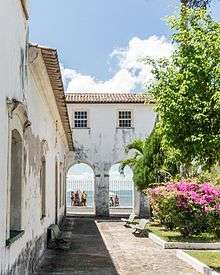Church of Our Lady of Penha
| Church of Our Lady of Penha | |
|---|---|
| Igreja de Nossa Senhora da Penha | |
 Garden of Church of Our Lady of Penha | |
 Location of the Church of Our Lady of Penha in Brazil | |
| Basic information | |
| Geographic coordinates | 12°54′34″S 38°29′48″W / 12.909539°S 38.496552°W |
| Affiliation | Catholic |
| Rite | Roman Rite |
| Municipality | Salvador |
| State | Bahia |
| Country | Brazil |
| Heritage designation | 1941 |
| Ownership | Roman Catholic Archdiocese of São Salvador da Bahia |
| Completed | 1742 |
| Designated | 1941 |
| Reference no. | 276 |
The Church of Our Lady of Penha (Portuguese: Igreja de Nossa Senhora da Penha, also Igreja de Nossa Senhora da Penha da Itapagipe and Nossa Senhora da Penha de França) is an 18th-century Roman Catholic church in Salvador, Bahia, Brazil. The church is located in the Ribeira neighborhood and constructed in 1742 as an extension of the Summer Palace of the Archbishop of the Roman Catholic Archdiocese of São Salvador da Bahia. The church sits at the end of the Itapagipe Peninsula and faces the Bay of All Saints. The Church of Our Lady of Penha was listed as a historic structure by the National Historic and Artistic Heritage Institute in 1941.[1][2]
History
It was constructed in 1742 by the José Botelho de Matos, Archbishop of Roman Catholic Archdiocese of São Salvador da Bahia as an extension of his summer home. The church was left to the Archdiocese after the death of de Matos in 1767. It was used by various Catholic brotherhoods between 1813 and 1916 and is now property of the Archdiocese.[1]
Structure
The exterior of the Church of Our Lady of Penha is in stone and brick masonry. The façade is in the Roccoco style and decorated with pieces of azulejos with a single tower. The interior of the church has three Baroque-style altars and the nave has an elaborate painting by an unknown artist. The church and Summer Palace are connected by a distinctive loggia, or roofed gallery. The palace is structured around a central hall.[1]
The church, unlike others in the historic center of Salvador, is surrounded by the beaches, a residential neighborhood, and streets lined with tamarind trees.
Protected status
The Church of Our Lady of Penha was listed as a historic structure by the National Historic and Artistic Heritage Institute in 1941. The heritage designation includes both the church and the Summer Palace of the Archbishop. The structures were registered under the Book of Historical Works, Inscription 276-T and Book of Fine Arts, Inscription fl 53. Both directives are dated September 25, 1941.[1][2]
References
- 1 2 3 4 Carrazzoni, Maria, ed. (1980). Guia dos bens tombados (in Portuguese). Rio de Janeiro, RJ: EXPED-Expansão Editorial. p. 60. ISBN 9788520800577.
- 1 2 "Igreja de Nossa Senhora da Penha e Palácio de Verão dos Arcebispos (Salvador, BA)". Brasília: Instituto do Patrimônio Histórico e Artístico Nacional. Retrieved 2017-02-14.